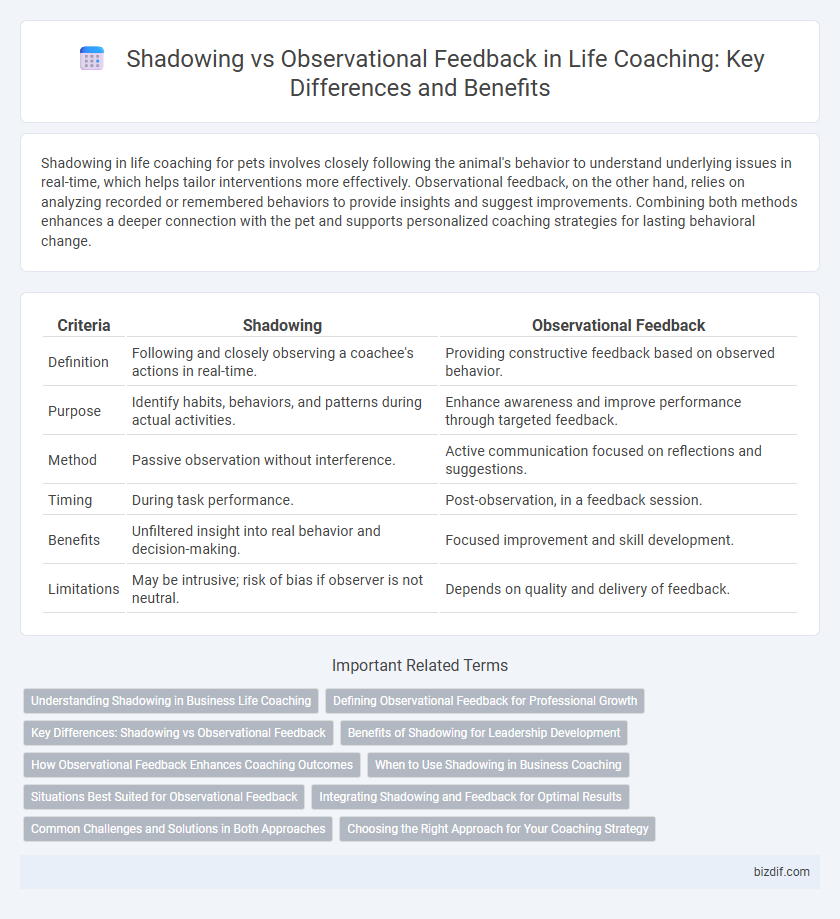Shadowing in life coaching for pets involves closely following the animal's behavior to understand underlying issues in real-time, which helps tailor interventions more effectively. Observational feedback, on the other hand, relies on analyzing recorded or remembered behaviors to provide insights and suggest improvements. Combining both methods enhances a deeper connection with the pet and supports personalized coaching strategies for lasting behavioral change.
Table of Comparison
| Criteria | Shadowing | Observational Feedback |
|---|---|---|
| Definition | Following and closely observing a coachee's actions in real-time. | Providing constructive feedback based on observed behavior. |
| Purpose | Identify habits, behaviors, and patterns during actual activities. | Enhance awareness and improve performance through targeted feedback. |
| Method | Passive observation without interference. | Active communication focused on reflections and suggestions. |
| Timing | During task performance. | Post-observation, in a feedback session. |
| Benefits | Unfiltered insight into real behavior and decision-making. | Focused improvement and skill development. |
| Limitations | May be intrusive; risk of bias if observer is not neutral. | Depends on quality and delivery of feedback. |
Understanding Shadowing in Business Life Coaching
Shadowing in business life coaching involves closely following a client or professional during their daily activities to gain deep insights into their behavior, decision-making, and work environment. This immersive approach allows coaches to identify unconscious patterns and emotional triggers that may hinder performance, enabling tailored strategies for personal and professional growth. Unlike observational feedback, which offers external critique, shadowing provides context-rich, nuanced understanding essential for effective transformational coaching.
Defining Observational Feedback for Professional Growth
Observational feedback in life coaching involves a coach carefully watching a client's behavior, communication, and decision-making processes to provide objective insights that foster self-awareness and professional growth. This form of feedback focuses on specific actions and patterns, enabling clients to identify strengths and areas for improvement without the coach intervening during the observation phase. By relying on evidence-based observations, clients can develop targeted strategies to enhance their personal effectiveness and achieve meaningful progress.
Key Differences: Shadowing vs Observational Feedback
Shadowing in life coaching involves closely following a client or coach in real-time to gain deeper insights into behaviors and decision-making processes, whereas observational feedback focuses on reviewing specific actions or sessions to provide targeted reflections. Shadowing captures the holistic experience and subtle nuances in interactions, while observational feedback zeroes in on distinct moments for constructive critique. The key difference lies in shadowing's immersive approach compared to the analytical nature of observational feedback.
Benefits of Shadowing for Leadership Development
Shadowing in leadership development provides personalized insights by allowing emerging leaders to observe decision-making processes and interpersonal dynamics in real-time. This immersive experience enhances emotional intelligence and situational awareness, fostering practical skills beyond theoretical knowledge. By engaging directly with experienced leaders, individuals develop confidence and adaptability crucial for effective leadership growth.
How Observational Feedback Enhances Coaching Outcomes
Observational feedback provides life coaches with real-time insights into clients' behaviors, enabling tailored interventions that directly address underlying issues. By focusing on non-verbal cues and situational responses, observational feedback uncovers hidden patterns that shadowing alone might miss. This targeted approach enhances coaching outcomes by fostering greater self-awareness and promoting sustainable behavioral change.
When to Use Shadowing in Business Coaching
Shadowing is most effective in business coaching when the goal is to gain an in-depth understanding of a client's real-time decision-making, communication styles, and workplace interactions. This method provides coaches with direct observational data to identify behavioral patterns and areas for development that might not emerge through self-reporting or traditional feedback. Employ shadowing during critical moments such as leadership transitions, conflict resolution, or when improving client engagement in team settings.
Situations Best Suited for Observational Feedback
Situations best suited for observational feedback in life coaching include moments where clients demonstrate new skills or behaviors in real-time, allowing coaches to provide immediate, specific insights. Observational feedback is effective during practical exercises, role-playing scenarios, or when clients engage in communication or decision-making tasks, as it captures non-verbal cues and contextual nuances. This approach helps clients become aware of unconscious habits and fosters self-awareness by reflecting on their actions within authentic situations.
Integrating Shadowing and Feedback for Optimal Results
Integrating shadowing with observational feedback enhances life coaching outcomes by providing real-time insights into client behaviors and thought patterns. Shadowing allows coaches to immerse in the client's environment, capturing authentic responses, while structured feedback offers targeted reflections to promote self-awareness and growth. Blending these techniques fosters a dynamic learning process, accelerating personal development and behavioral change.
Common Challenges and Solutions in Both Approaches
Common challenges in shadowing and observational feedback include biases from subjective perception and discomfort affecting authentic behavior. Solutions involve structured feedback frameworks and training observers to ensure objective assessments. Emphasizing clear communication and setting expectations enhances trust and effectiveness in both approaches.
Choosing the Right Approach for Your Coaching Strategy
Shadowing involves closely following a client's behavior to gain in-depth insights into their actions and thought patterns, while observational feedback relies on an external perspective to highlight areas for improvement. Selecting the right approach depends on the coaching objectives, client's comfort level, and desired outcomes, with shadowing offering immersive understanding and observational feedback providing objective analysis. Effective coaching strategies integrate these methods to tailor feedback that drives personal growth and clarity.
Shadowing vs Observational feedback Infographic

 bizdif.com
bizdif.com